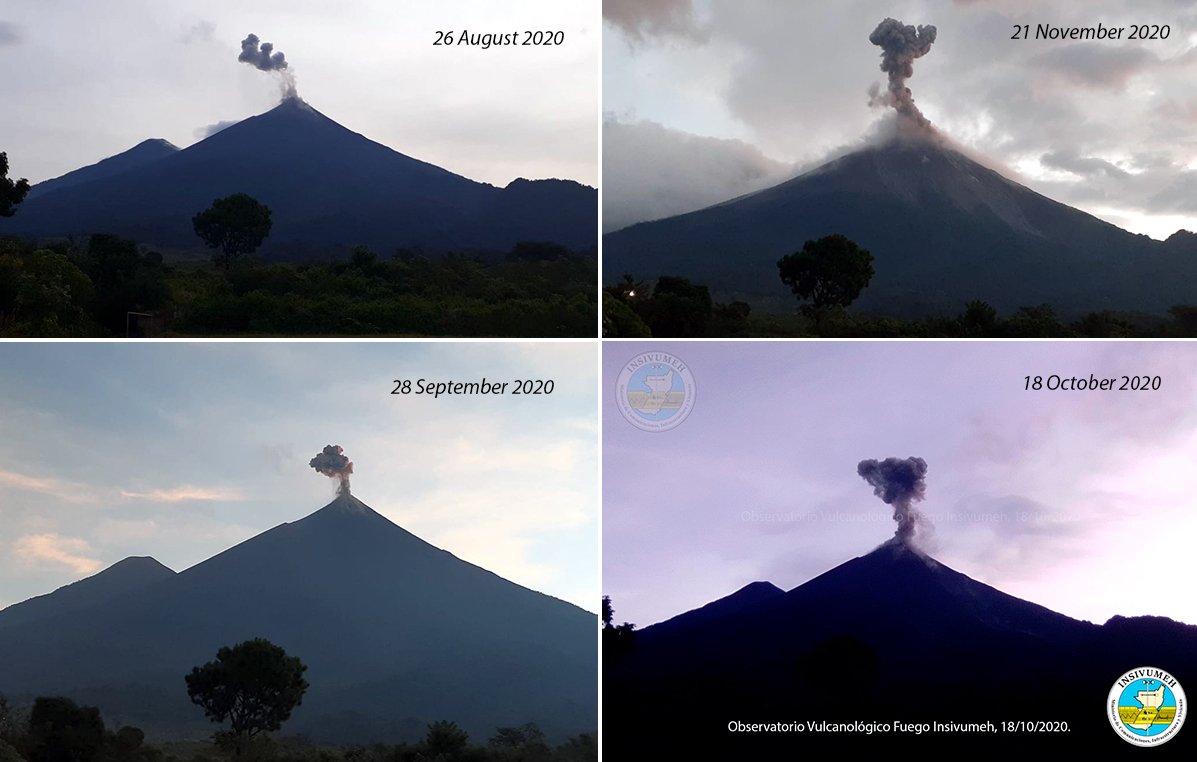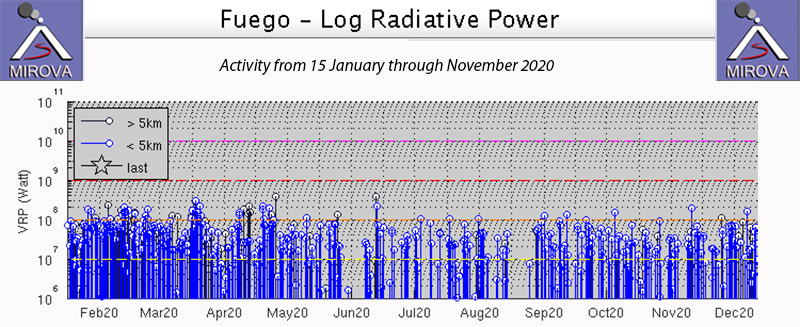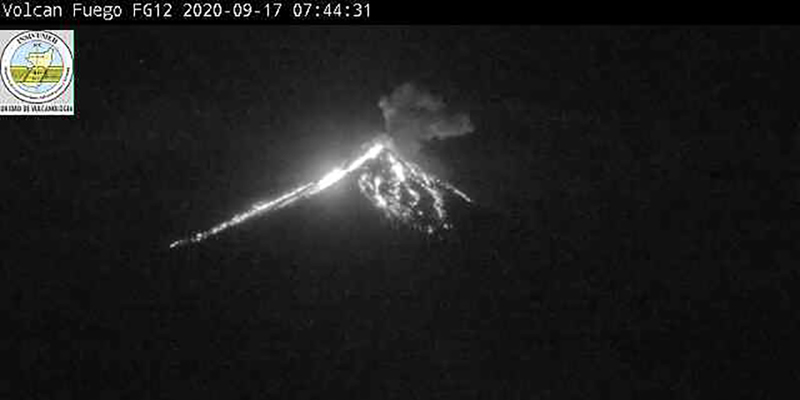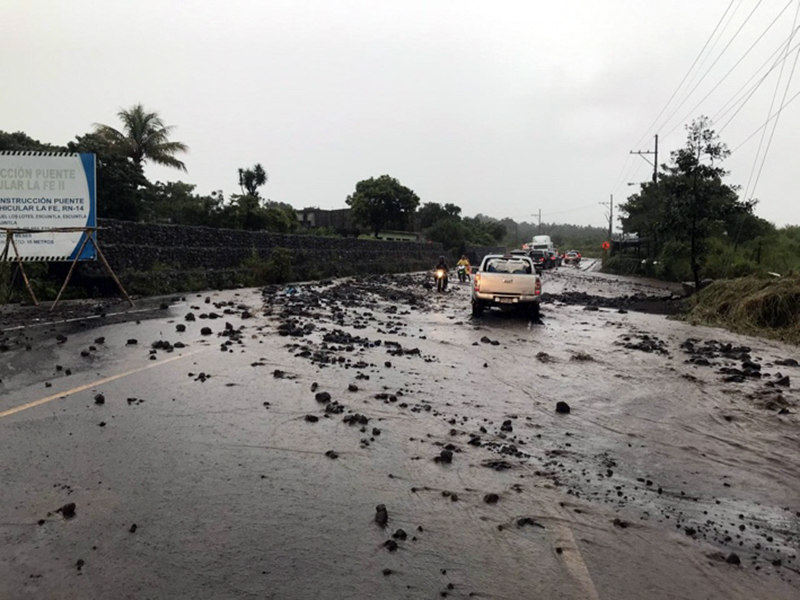Report on Fuego (Guatemala) — December 2020
Bulletin of the Global Volcanism Network, vol. 45, no. 12 (December 2020)
Managing Editor: Edward Venzke.
Edited by A. Elizabeth Crafford.
Fuego (Guatemala) Daily explosions, ash emissions, and block avalanches during August-November 2020
Please cite this report as:
Global Volcanism Program, 2020. Report on Fuego (Guatemala) (Crafford, A.E., and Venzke, E., eds.). Bulletin of the Global Volcanism Network, 45:12. Smithsonian Institution. https://doi.org/10.5479/si.GVP.BGVN202012-342090
Fuego
Guatemala
14.4748°N, 90.8806°W; summit elev. 3799 m
All times are local (unless otherwise noted)
Guatemala's Volcán de Fuego has been erupting vigorously since 2002 with reported eruptions dating back to 1531. These eruptions have resulted in major ashfalls, pyroclastic flows, lava flows, and damaging lahars, including a series of explosions and pyroclastic flows in early June 2018 that caused several hundred fatalities. Eruptive activity consisting of explosions with ash emissions, block avalanches, and lava flows began again after a short break and has continued; activity during August-November 2020 is covered in this report. Daily reports are provided by the Instituto Nacional de Sismologia, Vulcanología, Meteorología e Hidrologia (INSIVUMEH); aviation alerts of ash plumes are issued by the Washington Volcanic Ash Advisory Center (VAAC). Satellite data provide valuable information about heat flow and emissions.
Summary of activity during August-November 2020. Eruptive activity continued at Fuego during August-November 2020, very similar to that during the first part of the year (table 22). Ash emissions were reported daily by INSIVUMEH with explosions often in the 6-12 per hour range. Most of the ash plumes rose to 4.5-4.7 km altitude and generally drifted SW, W, or NW, although rarely the wind direction changed and sent ash to the S and SE. Multiple daily advisories were issued throughout the period by the Washington VAAC warning aviators about ash plumes, which were often visible on the observatory webcam (figure 136). Some of the communities located SW of the volcano received ashfall virtually every day during the period. Block avalanches descended the major drainages daily as well. Sounds were heard and vibrations felt from the explosions most days, usually 7-12 km away. The stronger explosions could be felt and heard 20 km or more from the volcano. During late August and early September a lava flow was active on the SW flank, reaching 700 m in length during the second week of September.
Table 22. Eruptive activity was consistently high at Fuego throughout August – November 2020 with multiple explosions every hour, ash plumes, block avalanches, and near-daily ashfall in the communities in certain directions within 10-20 km of the volcano. Courtesy of INSIVUMEH daily reports.
| Month | Explosions per hour | Ash Plume Heights (km) | Ash plume distance (km) and direction | Drainages affected by block avalanches | Communities reporting ashfall |
| Aug 2020 | 2-15 | 4.3-4.8 | SW, W, NW, S, N, 8-20 km | Seca, Taniluya, Ceniza, Trinidad, Las Lajas, Honda, Santa Teresa | Panimaché I and II, Morelia, Rochela, Finca Palo Verde, Yepocapa, Santa Sofia, El Porvenir, Palo Verde, Sangre de Cristo, Santa Lucía Cotzumalguapa |
| Sep 2020 | 3-16 | 4.3-4.9 | W, SW, NW, N, S, 8-20 km | Seca, Taniluya, Ceniza, Trinidad, Las Lajas, Honda, Santa Teresa | Panimaché I and II, Morelia, Santa Sofía, Finca Palo Verde, Sangre de Cristo, Yepocapa, Porvenir, Yucales, Ojo de Agua, Finca La Conchita |
| Oct 2020 | 3-19 | 4.1-4.8 | SW, W, S, SE, N, E, 10-20 km | Seca, Taniluya, Ceniza, Trinidad, Las Lajas, Honda, Santa Teresa | Panimache I and II, Morelia, Sangre de Cristo, Yepocapa, La Rochela, El Porvenir, Ceilán, Santa Sofía, Yucales, Finca Palo Verde |
| Nov 2020 | 4-14 | 4.0-4.8 | S, SW, SE, W, NW, 10-35 km | Seca, Taniluya, Ceniza, Trinidad, Las Lajas, Honda, Santa Teresa El Jute | Panimaché I and II, Sangre de Cristo, Morelia, Ceilan, La Rochela, El Zapote, Santa Sofía, Yucales, San Juan Alotenango, Ciudad Vieja, San Miguel Dueñas y Antigua Guatemala, Palo Verde, El Porvenir, San Pedro Yepocapa, Quisaché, Santa Emilia |
 |
Figure 136. Consistent daily ash emissions produced similar looking ash plumes at Fuego during August-November 2020. Plumes usually rose to 4.5-4.8 km altitude and drifted SW. Courtesy of INSIVUMEH. |
The frequent explosions, block avalanches, and lava flows produced a strong thermal signal throughout the period that was recorded in both the MIROVA project Log Radiative Power graph (figure 137) and in numerous Sentinel-2 satellite images (figure 138). MODVOLC data produced thermal alerts 4-6 days each month. At least one lahar was recorded each month; they were most frequent in September and October.
 |
Figure 137. The MIROVA graph of activity at Fuego for the period from 15 January through November 2020 suggested persistent moderate to high-level heat flow for much of the time. Courtesy of MIROVA. |
Activity during August-November 2020. The number of explosions per hour at Fuego during August 2020 was most often 7-10, with a few days that were higher at 10-15. The ash plumes usually rose to 4.5-4.8 km altitude and drifted SW or W up to 15 km. Incandescence was visible 100-300 m above the summit crater on most nights. All of the major drainages including the Seca, Santa Teresa, Ceniza, Trinidad, Taniluyá, Las Lajas, and Honda were affected by block avalanches virtually every day. In addition, the communities of Panimaché I and II, Morelia, Santa Sofía, Finca Palo Verde, El Porvenir, San Pedro Yepocapa, and Sangre de Cristo reported ashfall almost every day. Sounds and vibrations were reported multiple days every week, often up to 12 km from the volcano, but occasionally as far as 20 km away. Lahars carrying blocks of rocks and debris 1-2 m in diameter descended the SE flank in the Las Lajas and Honda ravines on 6 August. On 27 August a lava flow 150 m long appeared in the Ceniza ravine. It increased in length over the subsequent few days, reaching 550 m long on 30 August, with frequent block avalanches falling off the front of the flow.
The lava flow in the Ceniza ravine was reported at 100 m long on 5 September. It grew to 200 m on 7 September and reached 700 m long on 12 September. It remained 200-350 m long through 19 September, although instruments monitored by INSIVUMEH indicated that effusive activity was decreasing after 16 September (figure 139). A second flow was 200 m long in the Seca ravine on 19 September. By 22 September, active flows were no longer observed. The explosion rate varied from a low of 3-5 on 1 September to a high of 12-16 on 4, 13, 18, and 22-23 September. Ash plumes rose to 4.5-4.9 km altitude nearly every day and drifted W, NW, and SW occasionally as far as 20 km before dissipating. In addition to the active flow in the Ceniza ravine, block avalanches persisted in the other ravines throughout the month. Ashfall continued in the same communities as in August, but was also reported in Yucales on 4 September along with Ojo de Agua and Finca La Conchita on 17 September. The Las Lajas, Honda, and El Jute ravines were the sites of lahars carrying blocks up to 1.5 m in diameter on 8 and 18 September. On 19 and 24 September lahars again descended Las Lajas and El Jute ravines; the Ceniza ravine had a lahar on 19 September.
The same activity continued during October 2020 with regard to explosion rates, plume altitudes, distances, and directions of drift. All of the major ravines were affected by block avalanches and the same communities located W and SW of the summit reported ashfall. In addition, ashfall was reported in La Rochela on 2, 3, 7-9 and 30 October, in Ceilán on 3 and 7-9 October, and in Yucales on 5, 14, 18 and 19 October. Multiple strong explosions with abundant ash were reported in a special bulletin on 14 October; high levels of explosive activity were recorded during 16-23 October. Vibrations and sounds were often felt up to 15 km away and heard as far as 25 km from the volcano during that period. Particularly strong block avalanches were present in the Seca and Ceniza ravines on 20, 25, and 30 October. Abundant rain on 9 October resulted in lahars descending all of the major ravines. The lahar in the Las Lajas ravine overflowed and forced the closure of route RN-14 road affecting the community of San Miguel on the SE flank (figure 140). Heavy rains on 15 October produced lahars in the Ceniza, Las Lajas, and Hondas ravines with blocks up to 2 m in diameter. Multiple lahars on 27 October affected Las Lajas, El Jute, and Honda ravines.
On 8 November 2020 a lahar descended the Seca ravine, carrying rocks and debris up to 1 meter in diameter. During the second week of November 2020, the wind direction changed towards the SE and E and brought ashfall to San Juan Alotenango, Ciudad Vieja, San Miguel Dueñas, and Antigua Guatemala on 8 November. Especially strong block avalanches were noted in the Seca and Ceniza ravines on 14, 19, 24, and 29 November. During a period of stronger activity in the fourth week of November, vibrations were felt and explosions heard more than 20 km away on 22 November and more than 25 km away on 27 November. In addition to the other communities affected by ashfall during August-November, Quisaché and Santa Emilia reported ashfall on 30 November.
Geological Summary. Volcán Fuego, one of Central America's most active volcanoes, is also one of three large stratovolcanoes overlooking Guatemala's former capital, Antigua. The scarp of an older edifice, Meseta, lies between Fuego and Acatenango to the north. Construction of Meseta dates back to about 230,000 years and continued until the late Pleistocene or early Holocene. Collapse of Meseta may have produced the massive Escuintla debris-avalanche deposit, which extends about 50 km onto the Pacific coastal plain. Growth of the modern Fuego volcano followed, continuing the southward migration of volcanism that began at the mostly andesitic Acatenango. Eruptions at Fuego have become more mafic with time, and most historical activity has produced basaltic rocks. Frequent vigorous eruptions have been recorded since the onset of the Spanish era in 1524, and have produced major ashfalls, along with occasional pyroclastic flows and lava flows.
Information Contacts: Instituto Nacional de Sismologia, Vulcanologia, Meteorologia e Hydrologia (INSIVUMEH), Unit of Volcanology, Geologic Department of Investigation and Services, 7a Av. 14-57, Zona 13, Guatemala City, Guatemala (URL: http://www.insivumeh.gob.gt/ ); MIROVA (Middle InfraRed Observation of Volcanic Activity), a collaborative project between the Universities of Turin and Florence (Italy) supported by the Centre for Volcanic Risk of the Italian Civil Protection Department (URL: http://www.mirovaweb.it/); Sentinel Hub Playground (URL: https://www.sentinel-hub.com/explore/sentinel-playground);Hawai'i Institute of Geophysics and Planetology (HIGP) - MODVOLC Thermal Alerts System, School of Ocean and Earth Science and Technology (SOEST), Univ. of Hawai'i, 2525 Correa Road, Honolulu, HI 96822, USA (URL: http://modis.higp.hawaii.edu/); Washington Volcanic Ash Advisory Center (VAAC), Satellite Analysis Branch (SAB), NOAA/NESDIS OSPO, NOAA Science Center Room 401, 5200 Auth Rd, Camp Springs, MD 20746, USA (URL: www.ospo.noaa.gov/Products/atmosphere/vaac, archive at: http://www.ssd.noaa.gov/VAAC/archive.html).




